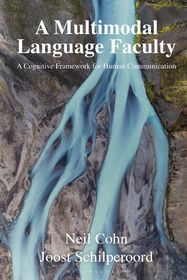
A Multimodal Language Faculty
A Cognitive Framework for Human Communication
- Publisher's listprice GBP 28.99
-
13 849 Ft (13 190 Ft + 5% VAT)
The price is estimated because at the time of ordering we do not know what conversion rates will apply to HUF / product currency when the book arrives. In case HUF is weaker, the price increases slightly, in case HUF is stronger, the price goes lower slightly.
- Discount 10% (cc. 1 385 Ft off)
- Discounted price 12 465 Ft (11 871 Ft + 5% VAT)
Subcribe now and take benefit of a favourable price.
Subscribe
13 849 Ft

Availability
Not yet published.
Why don't you give exact delivery time?
Delivery time is estimated on our previous experiences. We give estimations only, because we order from outside Hungary, and the delivery time mainly depends on how quickly the publisher supplies the book. Faster or slower deliveries both happen, but we do our best to supply as quickly as possible.
Product details:
- Publisher Bloomsbury Academic
- Date of Publication 11 December 2025
- Number of Volumes Paperback
- ISBN 9781350402454
- Binding Paperback
- No. of pages pages
- Size 234x156 mm
- Language English
- Illustrations 83 bw illus 700
Categories
Long description:
Natural human communication is multimodal. We pair speech with gestures, and combine writing with pictures from online messaging to comics to advertising. This richness of human communication remains unaddressed in linguistic and cognitive theories which maintain traditional amodal assumptions about language. What is needed is a new, multimodal paradigm.
This book posits a bold reorganization of the structures of language, and heralds a reconsideration of its guiding assumptions. Human expressive behaviors like speaking, signing, and drawing may seem distinct, but they decompose into similar cognitive building blocks which coalesce in emergent states from a singular multimodal communicative architecture. This cognitive model accounts for unimodal and multimodal expression across all of our modalities, providing a "grand unified theory" that incorporates insights from formal linguistics, cognitive semantics, metaphor theory, Peircean semiotics, sign language, gesture, visual language, psycholinguistics, and cognitive neuroscience. Such a perspective reconfigures how we understand linguistic structure, diversity, universals, innateness, relativity, and evolution. A Multimodal Language Faculty directly confronts centuries-old notions of language and offers a compelling reimagination of what language is and how it works.
Table of Contents:
List of Figures
List of Tables
Part I: Foundations
1. Reimagining Language
Part II. Modalities
2. What is a Modality?
3. Interfacing Between Modalities
Part III: Meaning
4. Conceptual Structures for Multiple Modalities
5. Multimodal Semantic Interactions
Part IV: Grammar
6. The Complexity Hierarchy
7. Interactions Between Combinatorial Schemas
Part V: Multimodality
8. Unimodal Expressions in a Multimodal Model
9. Independent Multimodal Interactions
10. Substitutive Multimodal Interactions
Part VI: A Multimodal Language Faculty
11. Consequences of a Multimodal Language Faculty
12. Evolution of a Multimodal Language Faculty
13. Towards a Multimodal Linguistics
References
Index




